 it
it  en
en
Archive 2021
The Bird Strike Committee Italy has released its usual annual report (in Italian) on the state of wildlife strikes in Italy. While suggesting to read the exhaustive document, we propose our own brief comment.
As a sort of paradox, the most feared object today by air traffic control, namely the UAS (aka the drone), is being tested to keep under control and disperse wildlife, especially the flying one. Actually, an experiment is underway at Brussels airport with the use of these devices, which can be equipped with a video camera and also with some removal system such as distress calls. This of course under the strict control of the TWR and in the absence of air traffic.
This writer observed in 1998, in Cleveland (OH), the use of a remote-controlled model aircraft to drive away gulls. It was a demonstration in the context of a conference and was successful, in the sense that the birds were actually dispersed. However, the gulls were harassed, but not frightened, as would have happened if there had been a real large bird of prey instead of a model aircraft. When the harassment ended, the gulls quickly returned to the place. This aspect was understood in Italy by two researchers, Iori and Gamberini, who created a model aircraft with a silent electric motor, but in the shape of a goshawk (Accipiter gentilis). Several tests were then carried out, the results of one of which, at Rome Fiumicino airport in 2007, were presented during a conference in Brazil (the full paper can be found on this website in the page Papers: “Beyond Falconry between tradition and modernity…”). However, the industrial initiative failed for a number of reasons, the patent was sold and the Falco Robot, that was the original name, was marketed by others.
The model aircraft in the shape of a bird of prey really caused the "terrifying" effect, which resulted in long periods of absence from the place of employment of almost all the bird species. In common with the drone, it also had the possibility of driving away the flocks of birds in the desired direction, avoiding chaotic dispersions.
We therefore believe that if Belgian researchers will manage to add the primordial and genetic terror of birds of prey, common to many birds, to the harassment effect, the device will contribute significantly to airport safety.
Who knows how many times I have heard this seemingly logical question. Obviously there are reasons, well explained in this video.
Last year we reported this event which has been classified as an accident; the Japanese authority issued a progress report specifying that the impact occurred after take-off at 8500 ft. and 8 NM from the departure airport. In the absence of abnormal parameters, the crew continued the flight to their destination, finding damage to the fuselage and internal structures only after a post flight inspection. Umpteenth case of continuation of the flight even in presence of an ascertained bird strike whose effects are not fully known.
As was to be expected, the enormous and often uncontrolled diffusion of drones (UAS) is beginning to have its harmful effects on aviation. On August 22, a drone struck an Embraer 175 over Chicago, forcing it to make a hasty landing. On August 10, a Toronto police drone caused severe damage to a Cessna 175 while at 500 ft. on landing.
This is what comes to light from a study by the American Cornell University, according to which 90% of the impacted species concerns migratory birds.
https://news.cornell.edu/stories/2021/08/planes-four-times-likely-hit-birds-during-migrations
Countless by now are our comments relating to events of flight continuation in the absence of abnormal parameters, after a bird strike ascertained, or even suspected, by the crew. Landing back immediately after take-off means literally to throw away a lot of money in fuel, and a lot of time, with possible repercussions on operations and in terms of image. For this reason, the eventuality is taken into consideration as a last resort and in the presence of specific conditions, such as the duration of the flight, the area to be flown over, the absence of safe alternate airports en route, weather conditions etc ...
But the decision taken by the crew of the Boeing 777 to fly from Panama City to Maastricht (see the event of August 15) after perceiving a burnt smell in the cabin, sign of probable ingestion of a bird in an engine, leaves us perplexed.
Invariably, upon arrival, the post flight inspection confirmed the worst suspicions that have remained unheard.
- 7 July 2021 – Manchester
Air Baltic A220, a post flight inspection revealed a bird strike on the leading edge of the left wing; the aircraft was unable to perform the return flight which was cancelled. - 8 July 2021 – Brussels
Brussels Airlines A319during the initial climb the crew reported a problem at the right engine and the need to land back; the aircraft landed 15’ later but it needed to be replaced.
https://www.gva.be/cnt/dmf20210708_93650739 - 21 July 2021 – St. Petersburg (FL)
Allegiant A320, during the initial climb an engine ingested a bird; the crew decided to land back about 30’ later. The aircraft needed to be replaced.
https://spotonflorida.com/west-central-florida/2944323/allegiant-flight-bound-for-new-york.html - 22 July 2021 – Nuremberg
Austrian ERJ195, on approach suffered a bird strike. The aircraft was unable to continue the next sector which was cancelled. - 25 July 2021 – Syracuse (NY)
Allegiant A319, on approach the aircraft received a bird strike. The aircraft was unable to continue its schedule. - 28 July 2021 – Lafayette (LA)
CommutAir ERJ145, on approach suffered a bird strike. Minor damage. - 28 July 2021 – Dayton (OH)
Piedmont ERJ145, on approach a bird impacted a wing leaving a dent. - 30 July 2021 – Bristol
Easyjet A321, bird strike during the initial climb; the crew decided to land back about 20’ after departure; the aircraft needed to be replaced.
https://www.inverness-courier.co.uk/news/inverness-bound-flight-returns-to-bristol-following-bird-str-246315/ - 31 July 2021 – Sinop (Brazil)
Azul A320, on final a bird hit the radome causing a dent; the aircraft was unable to continue its schedule.
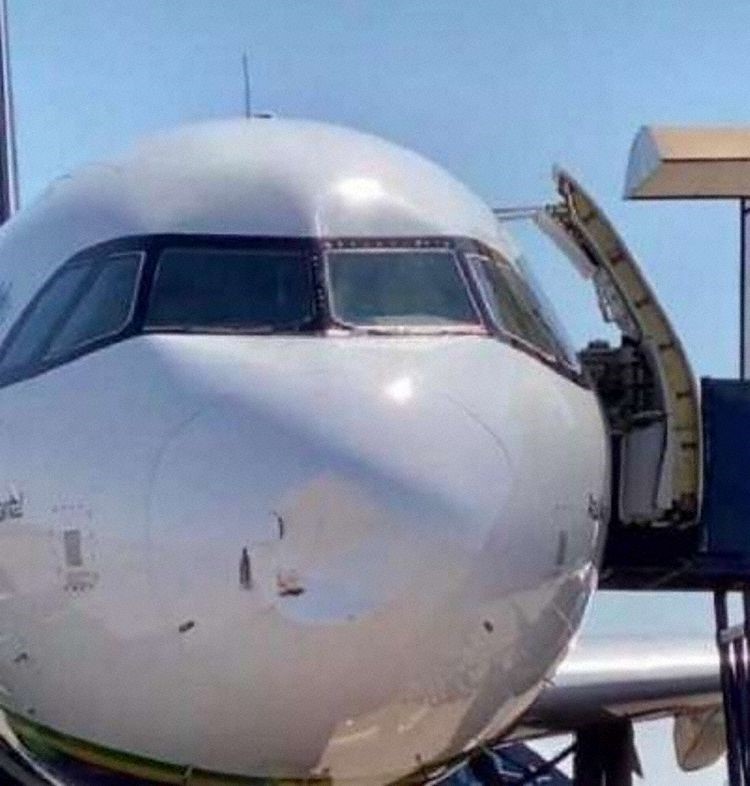
(The bent nose; photo taken from Avherald.com)
- 1 August 2021 – Tunis
Tunisair A320, during the initial climb a bird impacted the left wing and another bird was ingested by the left engine. Immediate return.
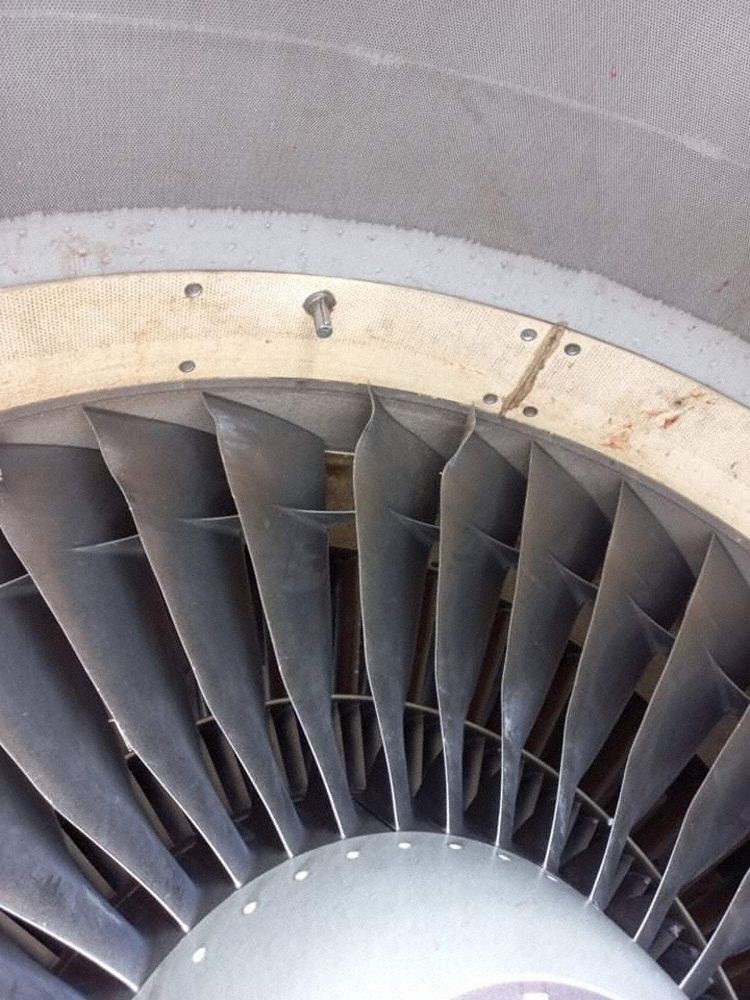
(Fan blades damaged; photo taken from Averald.com)
- 2 August 2021 – Burgas
Wizz A320, in the initial climb the right engine ingested a bird. The aircraft landed back 20’ after take off. - 2 August 2021 – Lahore
Airblue A321, bird strike on the initial climb; the crew decided to land back 12’ later; the aircraft needed to be replaced.
https://www.samaa.tv/news/2021/08/plane-survives-bird-strike-lands-safely-at-lahore-airport/ - 10 August 2021 - Havre-Saint-Pierre (Canada)
Air Inuit DHC-8, rejected take off due to a bird strike occurred on the runway. - 13 August 2021 – Syktyvkar (Russia)
Smartavia B737, collided with a fox during the landing roll. - 15 August 2021 – Panama City
Qatar B777, after take off the crew detected an odour in the cockpit and suspected a bird strike. In the absence of abnormal indications however the crew decided to continue the flight to Maastricht (10 hrs). A postflight inspection confirmed the left engine had ingested a bird.
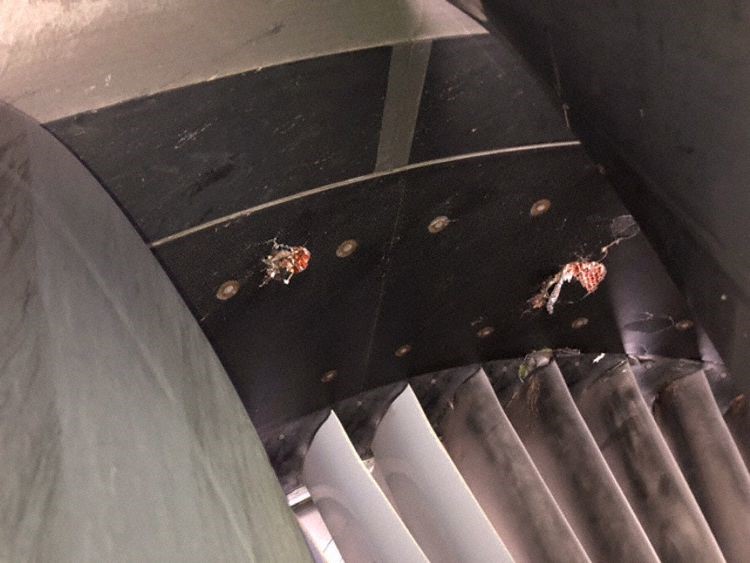
(The engine after landing; photo taken from Avherald.com)
- 16 August 2021 – Nanaimo (BC, Canada)
Westjet Encore, DHC8, on final at about 3NM from the runway struck a bird that caused damage. - 20 August 2021 – Boston
Delta B757, bird strike on final; minor damage to an engine cowling. - 22 August 2021 – Cork
Ryanair B737, in the initial climb suffered a bird strike; the crew decided to divert to London Stansted.
https://www.dailyadvent.com/gb/news/c64d66c9e6175ca6e08989c15cbb1788-Flight-from-Cork-to-Alicante-diverts-after-bird-strike-causes-rattle - 23 August 2021 – Winnipeg (Canada)
Cargojet Airways B767, reported a bird strike upon arrival having struck about 10 birds on the landing flare. A vehicle confirmed a number of seagull remains on the runway. The right engine sustained damage. - 24 August 2021 – Boston
Jetblue A320, bird strike on approach that left a dent in the right wing leading edge. - 25 August 2021 – Sept-Iles (QB, Canada)
Provincial Airlines DHC8, rejected take-off due to a bird strike. Found a bird carcasse on the runway. - 26 August 2021 – Winnipeg (Canada)
Air Canada A320, in the initial climb hit a bird; the crew decide to land back. Found the remains of two birds on the runway. - 27 August 2021 – Patna (India)
Indigo A320, in the initial climb at about 900 ft a bird was ingested into one of the engines damaging some fan blades; the crew landed back 15’ after take off.
https://timesofindia.indiatimes.com/city/patna/grounded-indigo-flight-leaves-airport/articleshow/85721712.cms - 28 August 2021 – Portland (OR)
Southwest B737, on final bird impacted the right hand wing damaging its wing leading edge. - 3 September 2021 – Accra (Ghana)
KLM B777, was accelerating for takeoff when the crew rejected takeoff at high speed (about 145 knots) due to an impact with one or more birds, one of which could have been ingested into an engine. The aircraft slowed safely, vacated the runway at the end and became disabled on the parallel taxiway due to a number of tyres on the right side deflating. The aircraft was then towed to the apron.
https://www.ghanaweb.com/GhanaHomePage/NewsArchive/Bird-disrupts-engine-of-KLM-flight-at-KIA-1348909 - 5 September 2021 – Guwahati (India)
Indigo A320, in the initial climb a bird was ingested into the right engine; immediate landing back with a number of fan blades damaged.
https://timesofindia.indiatimes.com/india/delhi-bound-flight-hit-by-bird-during-take-off-lands-safely-at-guwahati/articleshow/85979329.cms - 7 September 2021 – Chicago or Duluth (MN)
Republic ERJ175, a post flight inspection revealed minor damage to the fuselage as result of a bird strike. - 8 September 2021 – Mosca (Domodedovo)
S7 Sibir Airlines A320, in the initial climb the crew reported a bird strike and vibrations of the right engine; landed back about 20 minutes after departure. - 9 September 2021 – Oradea (Romania)
TAROM ATR72, rejected takeoff at low speed due to a rabbit on the runway that was hit with the nose gear. No damage but the aircraft needed to be replaced. - 12 September 2021 – Cayman Brac
Cayman Airways B737, landed back after few minutes from departure due to he impact of a bird on the windscreen. No damage.
https://caymannewsservice.com/2021/09/bird-hits-cal-windshield-on-brac-to-gc-flight/ - 14 September 2021 – Raipur (India)
Air India A320, rejected take off due to a bird strike.
https://www.republicworld.com/india-news/general-news/air-india-flight-collides-with-bird-at-takeoff-in-raipur-returns-to-runaway.html - 18 September 2021 – Sacramento (CA)
Horizon ERJ175, during the initial climb one or more birds hit the aircraft causing damage to the left engine and the radome; the crew decide to return and landed back 15’ after departure. - 23 September 2021 – Varadero (Cuba)
Azur Air B767, rejected takeoff at high speed (about 130 knots over ground) after a flock of birds impacted the aircraft causing the right hand engine to emit bangs and flames.
A post flight inspection also revealed damage to the aircraft's nose.
https://www.youtube.com/watch?v=bcPmRi0skgI
(passenger video) - 24 September 2021 – enroute between Atlanta and Cincinnati
Polar Air B767, bird strike while enroute caused minor damage to the nose. - 24 September 2021, New York (JFK)
Jetblue A321, the aircraft suffered a bird strike at take-off which apparently took a number of probes out. Still having basic instruments, but having lost a lot of their automation, the crew managed to return to JFK and landed back about 90 minutes after departure. - 29 September 2021 – New York (La Guardia)
United A319, on final visual approach the crew initiated a balked landing reporting birds. However the aircraft struck several birds on landing and post flight inspection revealed damage to the nose cone.
The event of 22 June (see below) highlights first of all the importance of a correct information to pilots about the presence of birds, but also their training (and that of ATC controllers) to deal with situations that should no longer be defined as unexpected.
From what is reported, it seems that the crew decided to go around because they spotted the flock of seagulls on the runway.
What we do know is that Alta airport is close to the sea, therefore with the probable frequent presence of seagulls.
We know that there was no notam in force regarding the possible presence of birds.
We also know that before the go-around the aircraft had not suffered any impact.
The video shows that the risk of a dual ingestion was very high, with all the possible consequences.
Is it normal that a large flock of seagulls settling and then flying over the runway are spotted first by the crew of an airplane in short final, or not rather by the TWR?
Was there a bird dispersal service, and if it there was, why was it not deployed to drive the birds away?
Would a correct and timely information have perhaps allowed a different assessment of the circumstances, avoiding a maneuver that could lead to more serious consequences?
On April 29, the presence of flocks of barn swallows and sparrows forced numerous arriving flights to short waits before being cleared to land at Taoyuan airport. Four flights were instead forced to divert to other airports on the island. Operations returned to normal after a few hours. The birds may have flocked to the airport because several days of rain have attracted insects.
- 26 March 2021 – Lviv
Wizzair A320, on approach suffered a bird strike at 4000 ft. During an inspection, a 3x4 cm radome fairing was found to be damaged, and the remains of blackbird got stuck in the hole. - 5 April 2021 – Nanaimo (BC, Canada)
Jazz Dash 8, during the climb at about 2500 ft. an eagle struck the aircraft just below the captain's windshield. The crew decided to continue the short flight at a reduced speed. At arrival the maintenance found a dent below the captain's windshield. - 10 April 2021 – Wausau (WI)
Endeavor CRJ200, rejected takeoff as a turkey impacted and damaged the left wing of the aircraft. The aircraft needed to be replaced. - 10 April 2021 – Grand Forks (ND)
Skywest CRJ900, bird strike in unknown circumstances. - 11 April 2021 – Taipei or Ho Chi Min City
China Airlines A350, after landing in Ho Chi Min City an inspection revealed damage to the left hand wing and fuselage, a hole with about 30cm (11 inches) diameter was found. The aircraft needed to be repaired before it could perform the return flight. It remained unclear when and where the bird strike had occurred. - 12 April 2021 – Pasco (WA)
Skywest ERJ175, in the initial climb received a bird strike; the aircraft landed back about 25 minutes after departure.
https://www.tri-cityherald.com/news/local/article250611694.html - 13 April 2021 – Chelyabinsk
S7 Sibir Airlines A320, was accelerating for takeoff when at about 130 KIAS a bird impacted the aircraft in the area of the left hand engine. In the absence of any abnormal indication the crew continued the flight to destination where a post flight inspection revealed that the bird had been ingested by the left hand engine and had caused damage in the area of the compressor. - 17 April 2021 – Sochi or St. Petersburg
Rossya A319, after an uneventful flight a post flight inspection revealed damage to the glass of the taxi headlight as well as two holes in the left outboard slats. - 21 April 2021 – Tho Xuan (Vietnam)
Vietnam Airlines A321, while landing received a bird strike damaging the aft brakes hydraulic line at the right main landing gear. The aircraft was unable to perform the return flight and had to be repaired. - 22 April 2021 – Chongqing (China)
China Eastern B737, during the initial climb a bird impacted the captain's windshield causing the outer pane to crack. The aircraft landed back about 30 minutes after departure. - 24 April 2021– Monastir (Tunisia)
Transavia B737, in the initial climb the left hand engine ingested a number of birds later causing engine vibrations. The crew decided to divert to Tunis where landed about 42 minutes after departure.
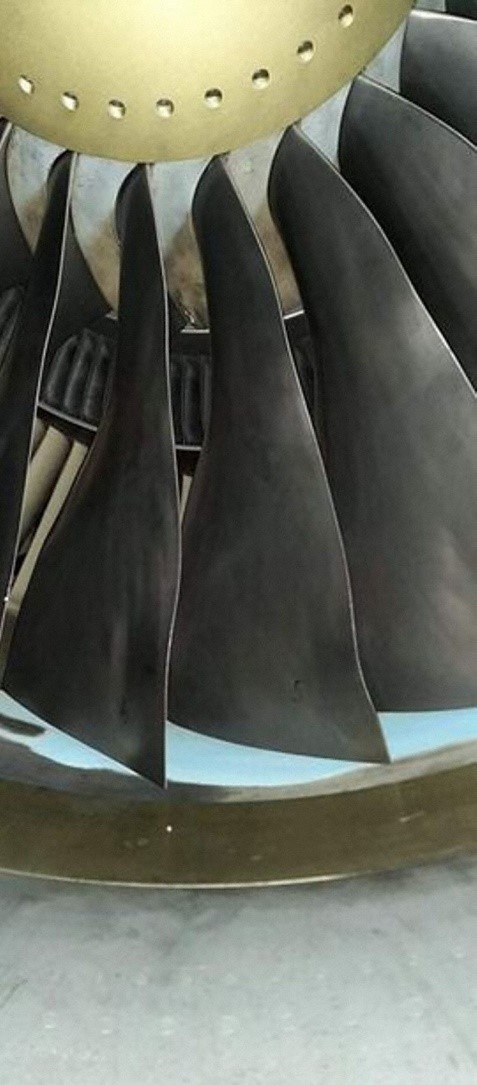
(The deformed fan blades; photo taken from Avherald.com)
- 25 April 2021 – Saint Petersburg
Rossya A319, on short final at about 20 ft. the left engine ingested a bird that damaged two fan blades. - 6 May 2021 – Los Angeles
Allegiant A319, during the initial climb the crew declared emergency reporting they had a bird strike into the right hand engine that caused remarkable vibrations. The aircraft landed back about 16 minutes after departure.
https://www.smdp.com/passenger-jet-lands-safely-in-la-after-bird-strikes-engine/204632 - 9 May 2021 – Ljubljana
Trade Air A320, during the initial climb the crew reported a bird strike causing an engine to perform poorly and decided to return. Tower subsequently advised that a harrier had been found on the runway. The aircraft landed back about 8 minutes after departure.https://english.sta.si/2898598/passenger-plane-forced-to-return-to-brnik-after-bird-strike - 9 May 2021 – Atlanta (GA)
Delta A320, during the initial climb the crew reported they had a bird strike and needed to return; subsequently declared emergency reporting a cracked right hand windshield. The aircraft landed back about 16 minutes after departure. - 9 May 2021 – Maracaibo (Venezuela)
Copa Airlines B737, during the initial climb an engine ingested a bird; the crew initially continued the flight but later on decided to return; he aircraft landed back about 35 minutes after departure. - 12 May 2021 – Seattle (WA)
Horizon Air Dash 8, struck a bird on landing leaving a small crack on the underside of the right wing. - 15 May 2021 – Louisville (KY)
UPS B767, on approach at about 6000 ft. the crew reported a suspected bird strike; a large dent in the radome was found after landing. - 17 May 2021 – Stockholm
SAS A320, bird strike during the initial climb; the crew decided to return and land back 15’ after departure. - 17 May 2021 – Marseille
Air France A319, rejected take off at the speed of 100 kts. further to the ingestion of a bird into the right engine; flight cancelled. - 17 May 2021 – Port Harcourt (Nigeria)
AeroContractors B737, was accelerating for takeoff when above V1 an engine ingested a bird and received blade damage. The crew continued takeoff and landed back about 8 minutes after departure.
https://www.vanguardngr.com/2021/05/just-in-ncaa-to-meet-faan-nama-over-bird-strikes-at-airports/ - 18 May 2021 – Kano (Nigeria)
Max Air B737, during the initial climb one of the engines ingested a bird prompting the crew to land back about 10 minutes after departure.
https://thenationonlineng.net/max-airs-flight-suffers-bird-strike/
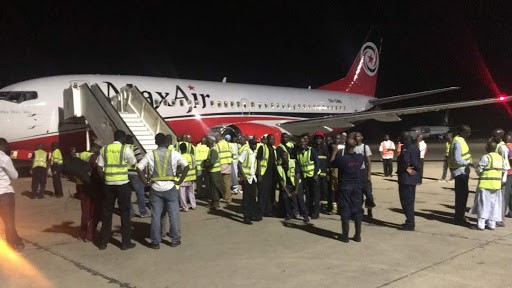
(The B737 after landing; photo taken from thenationonlineeng.net)
- 25 May 2021 – Orlando (FL)
Spirit Airlines A320, on approach struck a large bird that caused minor damage to the fuselage. - 26 May 2021 – Denver (CO)
Southwest B737, during the initial climb at least two large birds hit the aircraft; one of them was ingested into an engine while the other one damaged one landing light; the crew decided to land back 15’ after departure. - 27 May 2021 – Concepcion (Cile)
Jetsmart A320, in the initial climb the left hand engine ingested a bird prompting the crew to land back about 20 minutes after departure. The engine suffered substantial damage. - 29 May 2021 – Yellowknife (Canada)
Canadian North B737, in the initial climb the left engine suffered a compressor stall/surge followed by abnormal engine noises. The crew decide to land back about 20 minutes after departure. An inspection by maintenance revealed evidence of a bird ingestion, the vortex dissipator was damaged. Further inspection revealed significant damage to the fan blades. - 30 May 2021 – Moscow Sheremetievo or Novosibirsk
Aeroflot A320, a postflight inspection revealed evidence of a bird strike, the radome showed a hole of 45mm diameter and a detachment of about 250mm. - 5 June 2021 – Saint Vincent (Saint Vincent and Grenadines)
American Airlines B737MAX, rejected take off at high speed when a flock of birds (apparently gulls) flew up on the runway and a number of bird strikes occurred.
https://searchlight.vc/news/2021/06/08/bird-strike-forces-aa-flight-to-abort-takeoff-from-aia
https://www.youtube.com/watch?v=P2x39bHponQ (source: News 784)
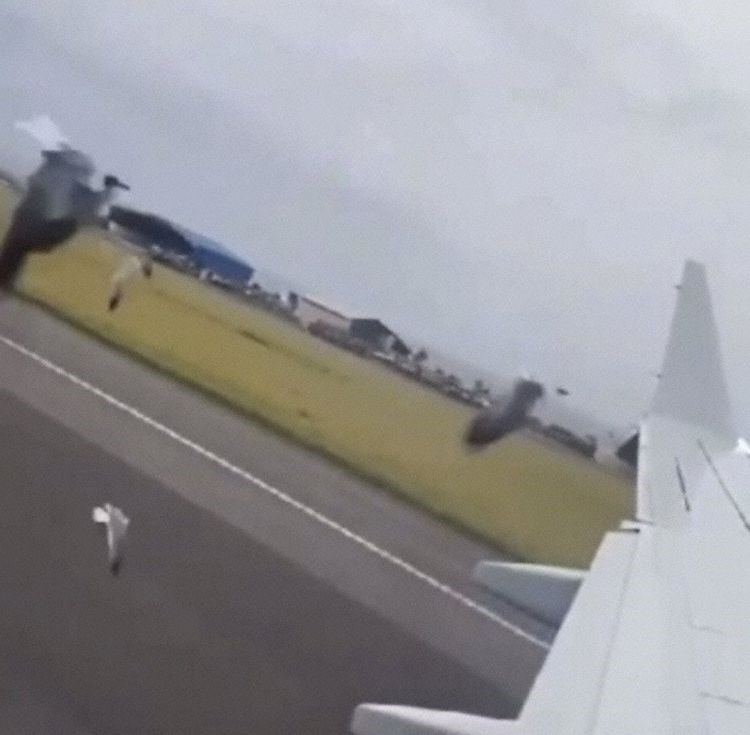
(Still frame out of passenger video (Photo: GaboAir taken from Avherald.com)
- 6 June 2021 – Joao Pessoa (Brazil)
LATAM A320, in the initial climb the crew decide to land back after the right hand engine ingested a bird and received damage. The aircraft landed about 25 minutes after departure. - 8 June 2021 – between Krasnodar and Moscow (Vnokovo)
Pobeda Airlines B737, after landing a post flight inspection revealed a bird had dented and punctured the leading edge of the left hand horizontal stabilizer.
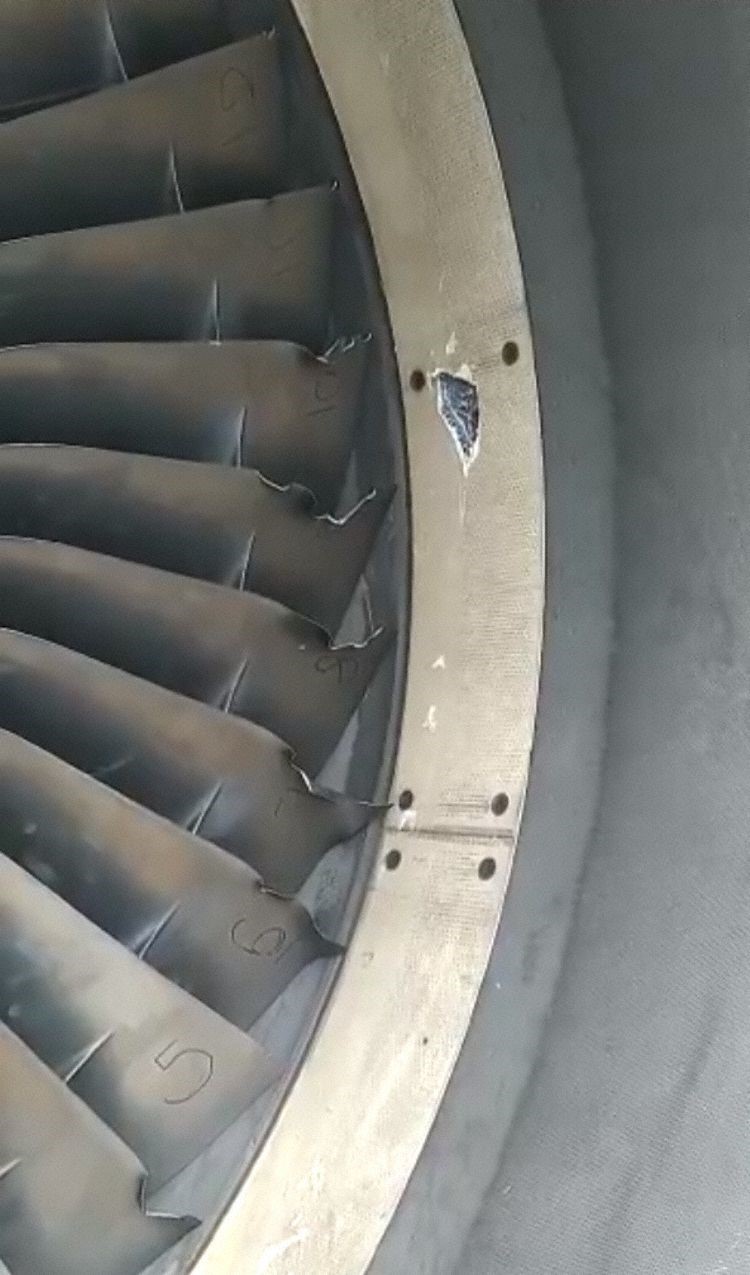
(Fan blade damage; photo taken from Avherald.com)
- 7 June 2021 – Orlando (FL), Delta B767
the crew advised they had a bird strike on takeoff right when they started to retract the landing gear, they had no abnormal indications and decided to continue to destination.
A post flight inspection revealed a dent on the nose cone. - 12 June 2021 – Baku
Azerbaijan Airlines A320, rejected takeoff at high speed (more than 122 knots over ground) after the left engine ingested a bird. - 13 June 2021 – Umea (Sweden)
SAS A320, on final approach an engine ingested a number of sea gulls.The aircraft was able to perform the return flight with a delay of 6 hours. - 14 June 2021 – Praia (Cape Verde)
TAP A321, on final approach one of the engines ingested a bird. The aircraft was unable to depart for the return flight. - 15 June 2021 – Paris (Roissy)
Air France A319, in the initial climb the crew reported a bird strike with strong noise at the left engine. The aircraft landed back 8 minutes after departure. - 22 June 2021 – Alta (Norvegia)
SAS A320, on final approach the crew spotted a flock of gulls ahead over the runway and initiated a go around. Climbing with the engines accelerating the crew could not avoid the right hand engine to ingest a bird. The aircraft landed about 8 minutes later but was unable to depart for the return flight and the flight was cancelled.
https://www.youtube.com/watch?v=FtlN9N6QZuE
Ground observer video (Video: Goliath Birdeater) - 24 June 2021 - Iasi (Romania)
TAROM ATR72, during the initial climb the crew reported a bird strike and decided to return. An inspection revealed that a wild hawk had collided with the aircraft and had left blood stains. A replacement aircraft needed to be dispatched. - 29 June 2021 – Frankfurt or Tunis
Lufthansa A320, a post flight inspection at Tunis airport revealed evidence of a bird strike. Return flight canceled.
The biennial WBA conference was held on 13 and 14 January 2021, this year in virtual mode due to the well-known Covid pandemic.
The written text of the presentation by Valter Battistoni, entitled "ATC & WHM: WHAT'S NEW" is available here.
The presentation highlights the significant steps forward that ICAO, in the opinion of the author, has made regarding the role of air traffic control in the prevention of wildlife strikes, futher to the publication of the new edition of Doc 9137 Part 3.
This is the solution adopted by Arusha airport in Tanzania. The airport manager recently stated that, though bird strikes were uncommon, it was still imperative to take precautionary measures that could prevent such catastrophes from happening.
It is not clear what will be shot nor the species of birds that mostly affect the airport.
They are specimens of an Indian dog breed called Mudhol, which is defined as “agile and intelligent”, and will be used to chase birds and other animals from operational areas. Border Collie dogs are already used in many airports. Four puppies were handed over to the airbase as part of a pilot project that sees the Agra base as the first experimental site. The goal is to drive away birds that mostly live on the ground, such as lapwings and larks. If the experiment will be successful it will be extended to other bases.
In a recentanalysis experts have found that mammals strikes with aircraft have been increasing by up to 68 percent annually. The analysis considered the annual reports from 47 countries. The species involved ranged from bats to deer, coyotes etc… and include also reptils.
The Pakistani Civil Aviation Authority has decided to install acoustic deterrent systems in some airports following the increase in bird strikes. According to the CAA officials, the system will be installed at the main and secondary runways of Jinnah International Airport, Karachi and Allama Iqbal International Airport, Lahore.
- 3 January 2021 – Istanbul
Turkish Airlines B777, durning the initial climb the aircraft flew through a flock of birds and received multiple bird strikes including the left hand pitot tube. The aircraft landed back about 45 minutes after take-off. The multiple bird strike caused a dent to the radome and to the left pitot tube.
https://www.aviation24.be/airlines/turkish-airlines/boeing-777-freighter-suffers-bird-strike-on-take-off-istanbul-turkey/
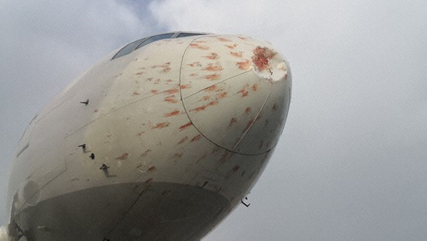
(Photo: ha effort melcey taken from Avherald.com)
- 3 January 2021 – Cancun (Mexico)
Aeromexico B787, rejected takeoff at low speed (about 60 knots) due to the failure of the left engine further to a bird ingestion; the engine emittede a muffled bang and a streak of flames.

(The bird ingestion; photo taken from https://www.riviera-maya-news.com)
- 3 January 2021 – Amsterdam
EAT Leipzig A300, at rotation the left hand engine emitted a bang and a streak of flames further to a bird ingestion. The crew decided to continue the flight to destination (Leipzig). In the photo is visible another bird that impacted the upper part of the right engine cowling and fell on the runway.
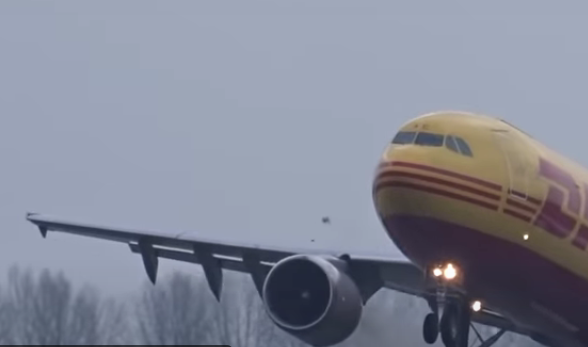
(Over the right engine is visible the bird that impacted on the engine cowling; photo PilotSanderHD taken from YouTube)
- 7 January 2021 – Sao Paulo (Guarulhos)
LATAM Brasil A320, during the acceleration for takeoff the aircraft hit a capybara on the runway. The crew continued takeoff then landed back to Sao Paulo about 65 minutes after departure. The runway was closed for about an hour for cleaning up. The capybara (Hydrochoerus hydrochaeris) is the largest living rodent in the world and typically weighs between 35 and 66 kg, top weights 91 kg. Minor damages to the aircraft are reported.
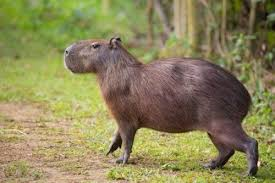
(A capybara; photo taken from imieianimali.it)
- 13 January 2021 – Harare
SA Airlink ERJ170, bird strike during the initial climb; landed back 35’ after departure. - 13 January 2021 – Houston (TX)
Spirit Airlines A320, during the take-off run struck a coyote on the runway. The crew landed back about 35 minutes after departure. The aircraft received unknown damage. - 16 January 2021 – Frankfurt
Lufthansa A320, rejected take-off at low speed (70 kts.) further to a bird ingestion into the right engine. - 16 January 2021 – Baltimore (MD)
Southwest B737, during the initial climb suffered a bird strike; landed back 40’ after take-off. Minor damage. - 23 January 2021 – Patna (India)
Vistara A320, at touchdown struck a bird; minor damage to an engine. - 23 January 2021 – Sarasota (FL)
Delta A321, bird strike on approach; minor damage. - 24 January 2021 – Tampa (FL)
Delta A319, multiple bird strike during take-off with bird ingestion into the left engine causing strong vibrations. Immediate return about 15’ after departure. The aircraft needed to be replaced.
https://simpleflying.com/delta-a319-bird-strike/ - 25 January 2021 – Brasilia
LATAM Brasil A320, in the initial climb suffered a bird strike that caused unreliable airspeed and multiple system faults. The aircraft landed back 45’ after departure.
https://newsakmi.com/travel-news/latam-airbus-a320-suffers-many-faults-after-bird-strike-simple-flying/ - 9 February 2021 – Rome (Fiumicino)
Alitalia A319, rejected take off at high speed (110 kts) further to a bird strike during the takeoff run. - 11 February 2021 – Dunedin (N. Zealand)
Air New Zealand A320, a bird strike on landing caused delay to a the subsequent flight; the aircraft with destination Auckland then was forced to divert to Christchurch for unknown reasons and had to be replaced.
https://www.odt.co.nz/news/dunedin/bird-strike-delays-flight-dunedin - 12 February 2021 – Johannesburg
KLM B777, rejected take off due to a multiple bird ingestion into one engine. - 24 February 2021 – Islamabad
AirSial A320, during the approach struck a bird that punctured a flap at the right wing section. The aircraft was unable to continue service. The next sectors had to be cancelled.
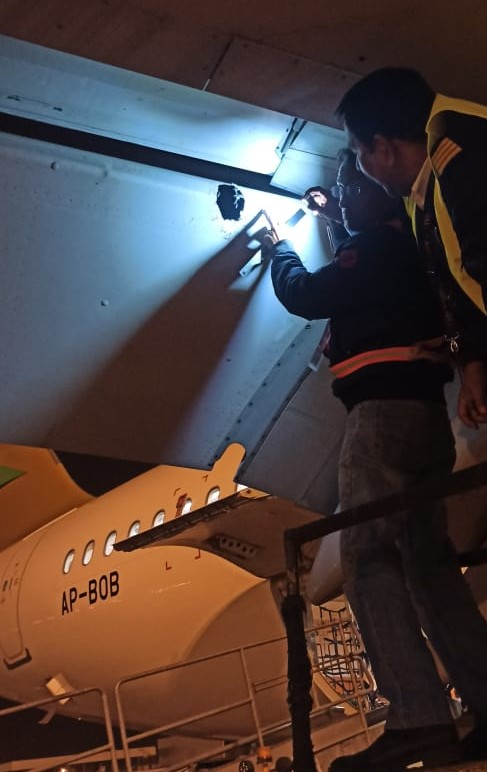
(Photo taken from Arynews.tv)
- 27 February 2021 – Little Rock (AK)
Southwest B737, on approach struck a bird that left a dent in the leading edge of the nose cone. - 28 February 2021 – Amsterdam
KLM B777, during the initial climb the aircraft received a bird strike(s) onto the left hand engine. In the absence of abnormal indications the crew initially continued the flight. A couple of hours later however the crew decided to return to Amsterdam. https://www.independent.co.uk/travel/news-and-advice/klm-flight-nowhere-bird-strike-amsterdam-b1809248.html
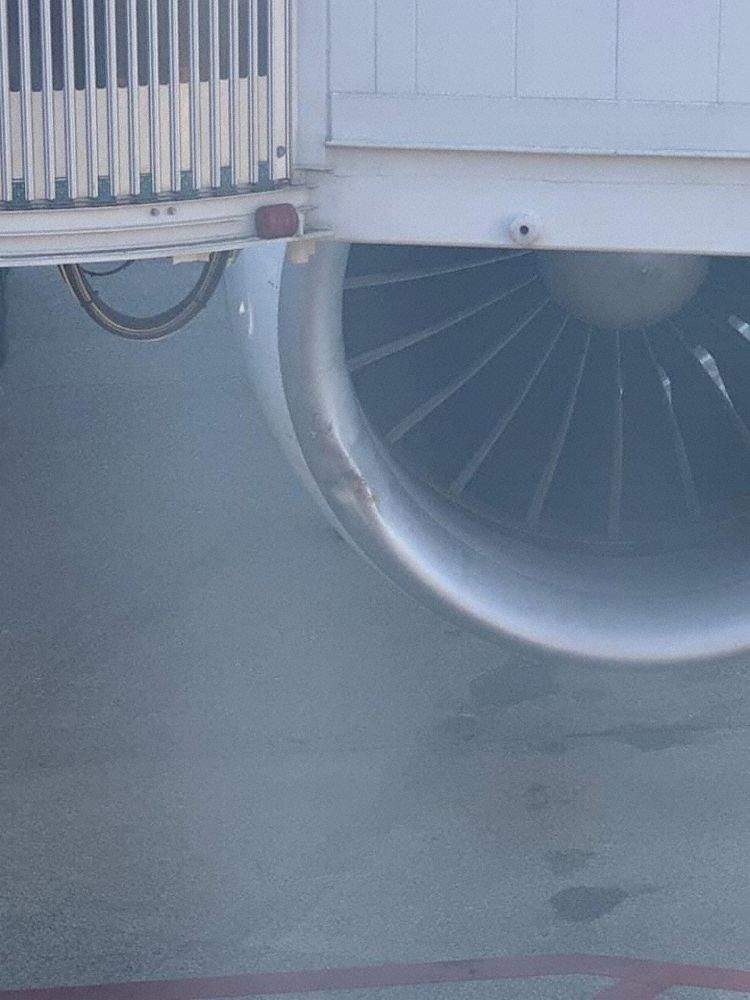
(The damaged engine; photo Menno Swart taken from Avherald.com)
- 4 March 2021 – Sao Luiz (Brazil)
Gol B737, during the initial climb the left engine ingested two birds and began to severely vibrate. The crew shut the engine down and decided to land back. Due to the bad weather the aircraft landed about 40 minutes after departure. Minor damage reported. - 9 March 2021 – Norfolk (VA)
American Airlines A320, after take off at 300 ft. struck a bird. After a first decision to continue the flight, the crew landed back 25’ after departure. - 9 March 2021 – Chicago (IL)
American Airlines A319, after take-off the left engine ingested a Canada Goose that caused high vibrations; the crew advised that the engine was operating nearly normal, but not normal enough to continue the flight. The aircraft landed back about 15 minutes after departure. - 16 March 2021 – Agadir
National Cargo B747, bird strike on approach; the aircraft was unable to continue its schedule; several tons of spare parts needed to be flown in for repairs. - 17 March 2021 – Karachi
PIA A320, during the initial climb the right engine ingested a bird. The crew decided to land back 9’ after take off.
https://www.pakistantoday.com.pk/2021/03/17/pias-passenger-flight-suffers-bird-strike-returned-to-karachi-airport-safely/ - 20 March 2021 – Dharamsala (India)
Air India Express ATR72, on approach about 20nm before touchdown a large bird, probably a vulture, impacted the aircraft at the right hand wing root. The aircraft received substantial damage.
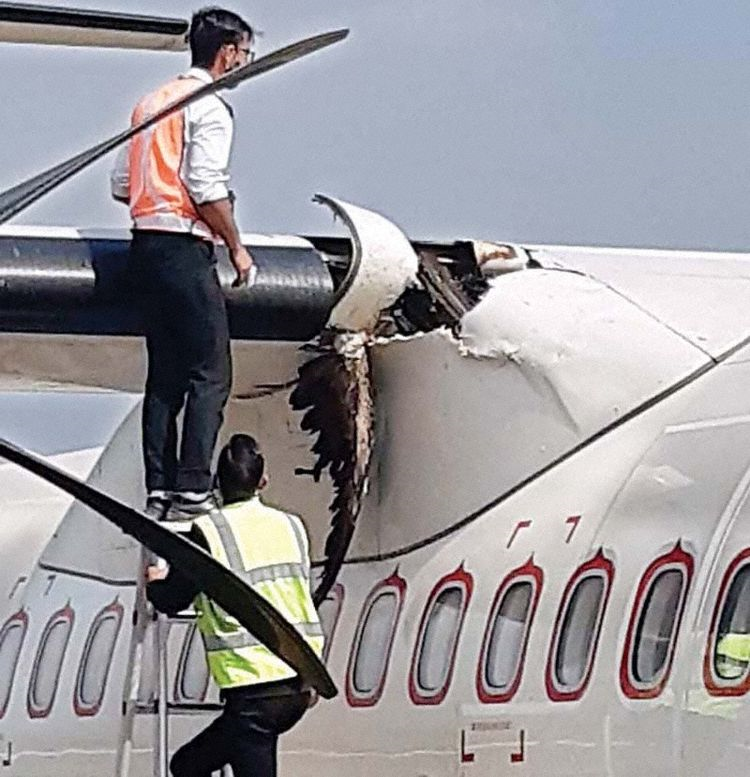
(Photo taken from Avherald.com)
- 21 March 2021 -Kano (Nigeria)
Aero Contractors B737, during the initial climb suffered a bird strike on one engine; the crew decided to return and landed back 16’ after take-off.
https://tribuneonlineng.com/bird-strike-forces-aero-contractors-plane-to-make-air-return-in-kano/ - 21 March 2021 – Little Rock (AR)
CommutAir ERJ145, on approach multiple birds collided with the aircraft. The aircraft was unable to continue its schedule due to a dent on the nose cone and rupturing on the fuselage. - 23 March 2021 – Fort Lauderdale (FL)
JetBlue A321, during the initial climb the crew reported they had a bird strike with ingestion into the left engine, that was reduced to idle power, and needed to return as soon as possible. While on final the crew reported a lot of birds at their right side at about 700 feet.
https://wsvn.com/news/local/possible-bird-strike-forces-jetblue-flight-to-return-to-fll-shortly-after-takeoff/ - 30 March 2021 – Salt Lake City (UT)
Delta B757, during the initial climb the left hand engine ingested at least one bird. The crew decided to return and landed back about 15 minutes after departure. The NBA team of Utah Jazz was on board of the aircraft.
https://kjzz.com/news/utah-jazz-charter-plane-lands-safely-in-slc-after-bird-strike
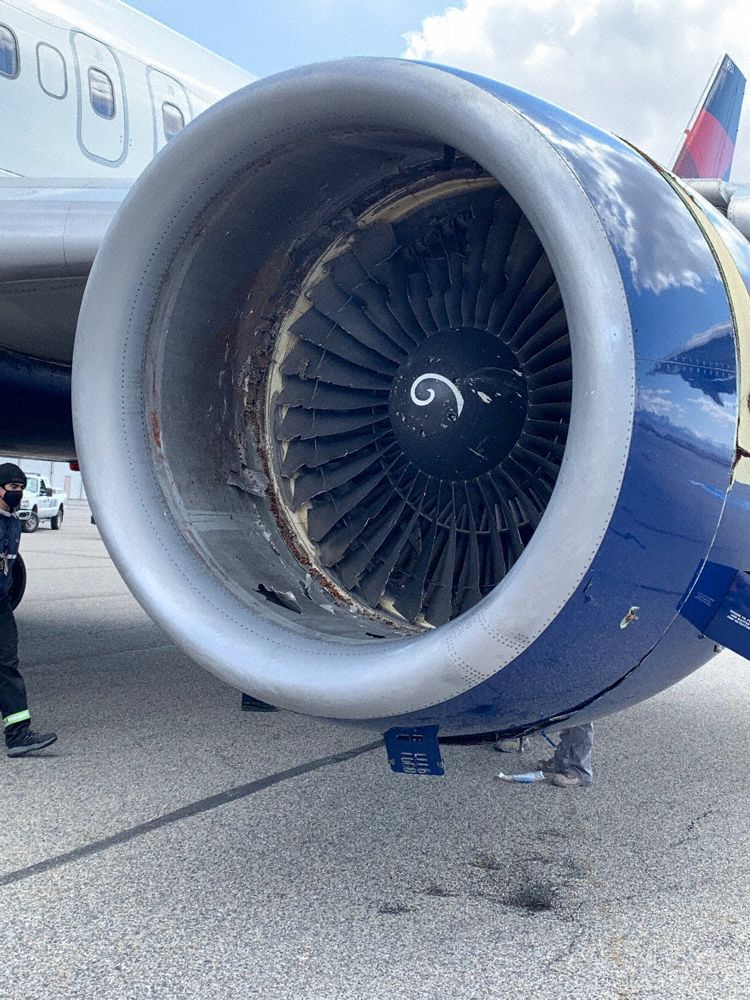
The left engine; photo Marc Sternfield taken from Avherald.com)
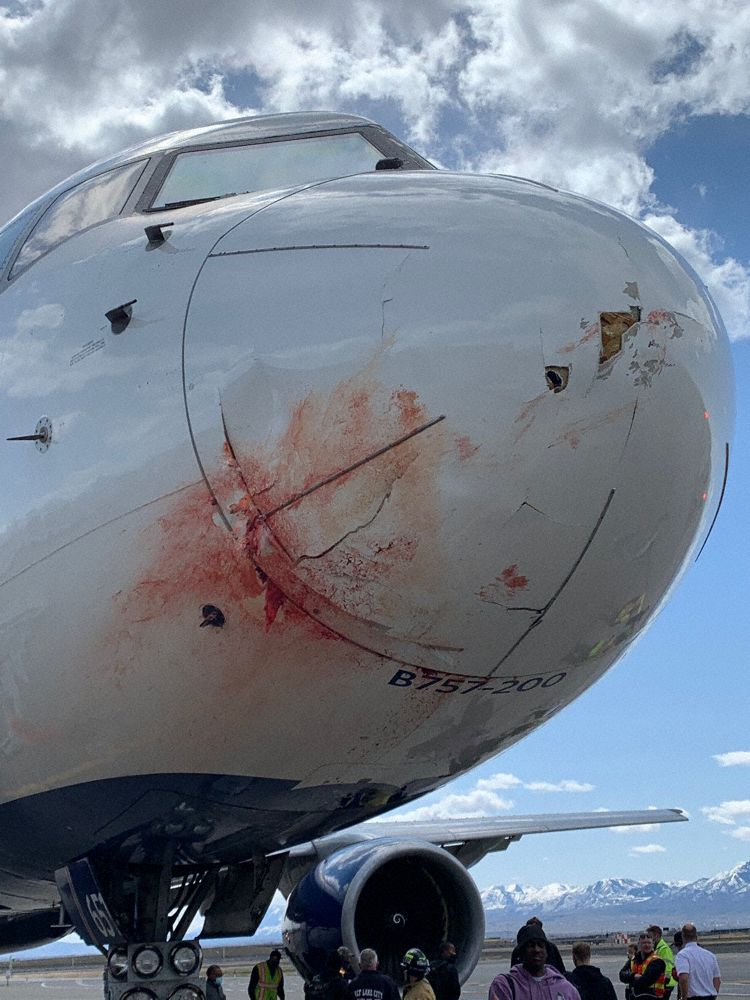
(Nose cone damage; photo Marc Sternfield taken from Avherald.com)
- 30 March 2021 – Atlantic City (NJ)
Spirit Airlines A320, during the initial climb the crew advised ATC they did have damage to outboard right leading edge slat due to a bird strike and needed to return; the aircraft landed back about 25 minutes after departure.